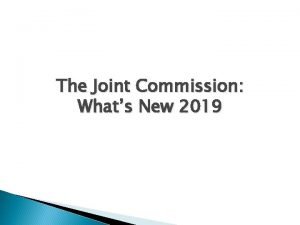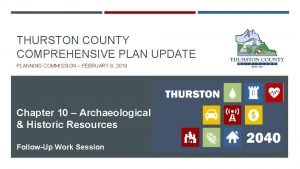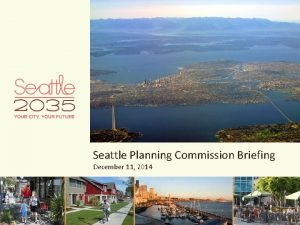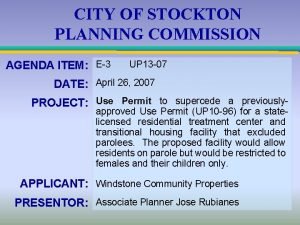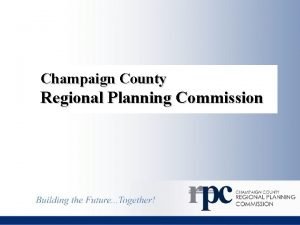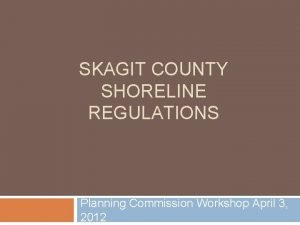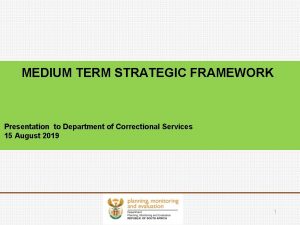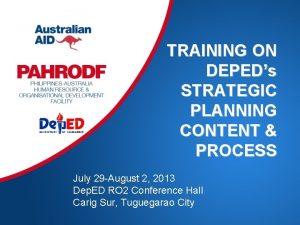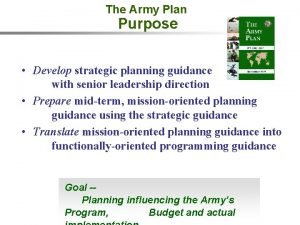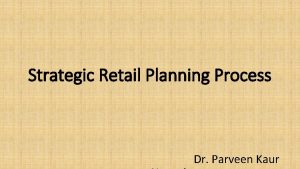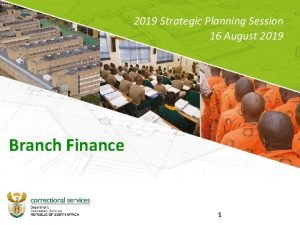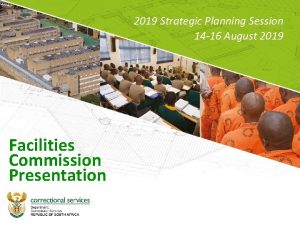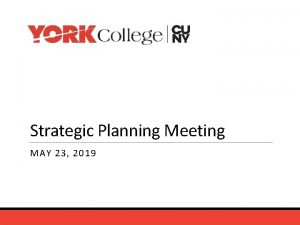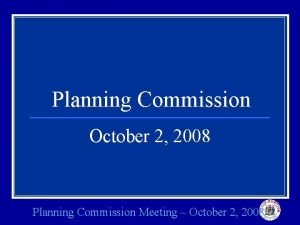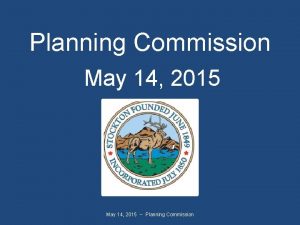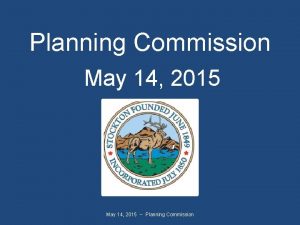2019 Strategic Planning Session 16 August 2019 Commission




















- Slides: 20

2019 Strategic Planning Session 16 August 2019 Commission 4: Community Corrections

15 August 1991 – 15 August 2019 Celebrating 28 Years of Community Corrections in South Africa!!!

Introduction • Community Corrections refers to all non-custodial measures and forms of supervision applicable to persons who are subject to such measures and supervision in the community and who are under the control of the Department • Correctional Supervision was implemented on 15 August 1991 in South Africa • During the year 2000 provision was made for the placement of Awaiting Trial Persons in the system of community corrections [62 (f)]

Summary of the 2018 Strategic Planning Session Modernisation of ICT systems Partnerships will stimulate economic growth in communities (economic stimulus) Dynamic Community Corrections system Established community relations in the field of Corrections Globalised approach to community corrections through artificial intelligence 50 Year Plan Corrections 10 Year Plan Community 5 Year Plan Professionalise

Current delivery method What are the core services How are these delivered (service delivery arrangements) Weaknesses with the current arrangements High level interventions / alternative mode of delivery Correctional and Parole Supervision Services Physical monitoring Categorization according to risk categories (High, Medium, Low risk) Accessibility of certain rural areas Location of community corrections offices Inadequate vehicles Decentralisation of offices (mobile offices, wireless) Enhance Partnerships (e. g. NHTL) Reintegration Services: • Community Liaison • Community Service • Reintegration Programmes Partnerships Halfway Houses Renovation of schools Employability of exoffenders Ambassadors programme Restorative Justice Stigmatization Buy-in by Judiciary in alternative sentencing Unemployment levels Promotion of noncustodial sentencing Expungement of criminal records Victim support

Environmental analysis External factors (external environmental scanning) enhancing or constraining Department’s operations and delivery: Constraining: • Unemployment (Employability of ex offenders) • Rejection of offenders by families and communities (Stigmatisation) • Dysfunctional family structures • Lack of support systems • Poverty • Peer pressure • Crime • Re-offending Internal: • Accessibility of services • Suitable vehicles • Trained officials

Environmental analysis External factors (external environmental scanning) enhancing or constraining Department’s operations and delivery: Enhancing / Enablers: • • • Job opportunities (Business sector) Restorative Justice Ambassadors programmes Sustainable Partnerships Acceptance by communities (Public education / awareness of parole decisions) Judiciary (Expansion of non-custodial sentencing options for petty offenders) Expungement of criminal records Accredited skills development Decentralisation of services Occupation specific training Suitable vehicles

Historical performance What has been achieved in What have we failed the past 5 years and what has to achieve in the worked well past 5 years and why What need to be done differently / change Compliance rate for parolees without violations increased from 94. 10% during 2013/14 to 99% by the end of 2018/19 • Partnerships with National House of Traditional Leaders, • Community Safety Forums, • Modern technology Compliance rate for probationers without violations increased from 92. 8% during 2013/14 to 99% by the end of 2018/19 Target achieved

Historical performance What has been achieved in the past 5 years and what has worked well What have we failed to achieve in the past 5 years and why What need to be done differently / change 17 halfway houses were established sinception and 528 parolees and probationers were reintegrated. Sinception all targets were achieved In 2018/2019 the target on reintegration of parolees and probationers through halfway house was not achieved Limited halfway Houses Challenges with procurement processes Resistance of communities to accept parolees residing in the Halfway Houses Revise business model for Halfway houses Establishment of service points increased from 6 to 958 through partnerships with external stake holders to enhance their accessibility of services Target achieved Increasing partnerships

Historical performance What has been achieved in the past 5 years and what has worked well What have we failed to achieve in the past 5 years and why What need to be done differently / change Participation of victims/offended has improved drastically since 2015 Participation of offenders remain very low compare to projected annual figure due to lack of knowledge and understanding of the process Improve public education on the mandate of correctional services Offenders are reluctant to participate in the program due to fear of meeting up with their victims

5 Year Strategic Plan - Results Chain Impact (Impact Statement) Outcome (5 year target) Primary Outputs (KPI’S) Compliance to conditions by of Probationers and Parolees Safer and empowered communities through sustainable economic development Successful reintegration of Offenders Parolees and Restorative Justice (RJ): Victim Offender Dialogue Probationers 5 year target: 97 % of offenders (Parolees and Probationers ) successfully reintegrated Accessibility of services within all districts

Operational Activities (5 Year) No Activity Time Frame Responsibility Employability of Probationers and Parolees 1) Audit and identify skills levels 2) Formalisation of co-operatives 3) Formalise collaboration with business sector / Seta’s 4) Provide accredited skills to enable Probationers and Parolees to contribute to economic development 5) Provision of “starter-pack tools” By 31 March 2021 CDC: Community Corrections 2 Reposition Social Reintegration (Community Corrections) under the umbrella of DCS with its own identity and branding 1) Development of Business case 2) Review Legislation and Policies 31 March ‘ 23 31 March ‘ 25 CDC: Community Corrections 3 Probationers and Parolees involved in Community Projects 1) Identify needs within communities 2) Formalising partnerships with Local Municipalities / Traditional Leaders 3) Involvement in Community and EPW projects 31 March 2021 CDC: Community Corrections 1 Dependencies: (Skills Development / Seta’s / Business sector / relevant State entities) Dependencies: District / Local Government

Operational Activities (5 Year) No Activity Time Frame Responsibility 4 Professionalise Community Corrections 1) Conduct needs analysis (Indaba) 2) Register work study and job analysis 3) Trained officials 4) Identification of vacancies 5) Development of occupation specific training curricula for Community Corrections at colleges 6) Development of placement criteria for Community Corrections 7) Allocation of dedicated resources for Community Corrections 31 March 2021 CDC: Community Corrections 5 Modernisation of ICT systems 1) Automated monitoring and supervision system (IIMS) 2) Integrated system across IJS (IIMS) 3) Accessibility of Social Reintegration services (App) 4) Access to system at all Community Corrections Offices (wire-less) 31 March 2020 CDC: Community Corrections Manufacturing of Mobile offices 1) Roving offices (similar to mobile clinics) – equipped with IT technology 2) Reprioritisation of budget for fleet (vehicles) – 1 amoured vehicle per region (e. g. VOC vehicle as ‘pilot’) 3) Manufacturing of “trailer” 31 March 2021 6 Dependency: CDC Gito CDC: Community Corrections

Operational Activities (5 -10 Years) No 1 Activity Time Frame Responsibility Foster Strategic partnerships for the successful reintegration 1) Continued implementation of the Stakeholder Management Strategy 2) Mobilization, collaboration of forums 3) Maintain relationships with stakeholders (NHTL, MOU) 4) Participate in intergovernmental structures 31 March 2029 CDC: Community Corrections

Operational Activities (10 -50 Years) No Activity Time Frame Responsibility 1 Innovation and technology 31 March 2068 CDC: Community Corrections 2 Utilisation of integrated technology 31 March 2068 to enhance the Correctional system CDC: Community Corrections

Resource considerations Available resources within the Branch • According to the 2003 post establishment structure, there are currently 2022 funded positions at community corrections of which 1843 are filled (Caseload: 71, 573) • Limited number of suitable vehicles utilised for monitoring • 218 Community Corrections Offices In view of the proposed budget cuts - how to optimise existing resources and extract optimal value: • To expand or improve the implementation of non-custodial measures, adequate investment in the administrative structures, staffing and training of the Community Corrections system need to be made. • Community Corrections cannot succeed in diverting offenders from incarceration unless it has a high degree of credibility with the judiciary, offenders and the community. • Partnerships with all stake holders in the corrections agenda

Critical success factors and dependencies Critical success factors: • Modernised technology • Increase in the participation of victims and offended in VOM/VOD • Increased / additional allocation from the Criminal Asset Recovery Account (CARA) • Increased Human capacity at Community Corrections • Occupation specific Social Reintegration training Dependencies: • Partnerships with Inter Departmental sector, NGO’s, CBO’s, NPO’s, FBO’s, Traditional leaders • Creation of employment opportunities for parolees and probationers • Expungement of criminal record • Alternative sentencing options (Community Service Orders)

Strategic Risks Outcome Risk Probab ility (High/ Mediu m/ Low) Impact (High/ Medium / Low) Mitigation Strategy Successful reintegrati on of Offenders Parolees and Probatione rs High Medium • Development of leasing guidelines in consideration with facilities at the regions and Head Office • Conduct Audit on safety of leased Community Corrections offices to determine the level of compliance. • Submitting the memorandum to facilities outlining all month to month lease agreements for possible improvement or increase the lease period, • Consult DPW to assist with possible relocation of Community Corrections offices to State building • Conduct an audit on available office accommodation in line with facilities • Utilization of service from other stakeholders (SAPS, Traditional leaders and community halls ) to assist with Community Corrections offices Non compliance to conditions

Strategic Risks Outcome Risk Probability (High/ Medium/ Low) Impact (High/ Medium/ Low) Mitigation Strategy Successful reintegration of Offenders Parolees and Probationers Rejection by communities Critical • Strengthen working relationship with stakeholders for coverage assistance in remote areas. • Involvements of all relevant stakeholders in the planning stage of the process. • Advocating the importance of working relationship with stakeholders on regular basis. • Request for training of current recruit to augment the monitoring of parolees. • Submit HR needs to HRP • Increase the advocacy coverage through additional media programmes, press and community dialogues

Highly Confidential Thank You THANK YOU STRIVING FOR A SOUTH AFRICA IN WHICH PEOPLE ARE AND FEEL SAFE 26
 Strategic planning vs tactical planning
Strategic planning vs tactical planning Defects in existing curriculum
Defects in existing curriculum What is graduated commission
What is graduated commission Opening prayer for meetings
Opening prayer for meetings Joint commission
Joint commission Strategic fit vs strategic intent
Strategic fit vs strategic intent Strategic substitute
Strategic substitute Io model strategic management
Io model strategic management Strategy analysis and choice largely involves making
Strategy analysis and choice largely involves making Project approval system in bangladesh
Project approval system in bangladesh Thurston county planning commission
Thurston county planning commission Seattle planning commission
Seattle planning commission City of stockton planning commission
City of stockton planning commission Rpc champaign il
Rpc champaign il Crpc baton rouge
Crpc baton rouge Skagit county setback requirements
Skagit county setback requirements What is medium term strategic framework
What is medium term strategic framework Why strategic planning is important to all managers?
Why strategic planning is important to all managers? Deped strategic planning sample
Deped strategic planning sample Army strategic planning guidance 2021
Army strategic planning guidance 2021 Retail management planning process
Retail management planning process




